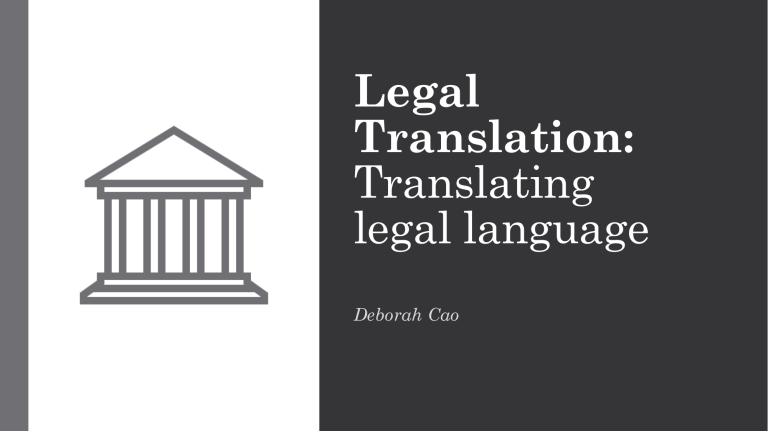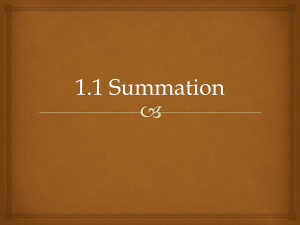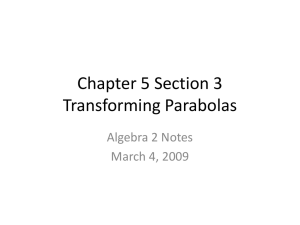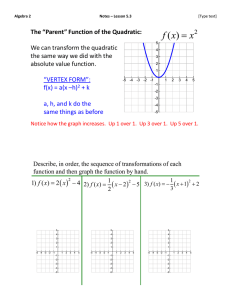
Legal Translation: Translating legal language Deborah Cao WHAT IS TRANSLATION? • Crystal (1991) defines translation as a process where “the meaning and expression in one language (source) is tuned with the meaning of another (target) whether the medium is spoken, written or signed”. • Torop (2002) has argued that translation, as a process of converting ideas expressed from one language into another, is embedded in the sociocultural language of a particular context and also described the translation process as basically a boundary-crossing between two different languages. The translation of law has played an important part in the contact between different peoples and different cultures in history and is playing an even more important role in our increasingly globalized world. Legal translation • It refers to the translation of texts used in law and legal settings. • It is a type of specialist or technical translation. • It involves special language use, that is, the use of Language for Special Purpose (LSP) or Language for Legal Purpose (LLP). Legal language and legal texts • Legal language refers to the language of law and its relation to law and legal process. • Legal language is a variety of language appropriate to different legal occasions and legal situations of use. Four major variants of written legal texts: Legislative texts Judicial texts Legal scholarly texts Private legal texts Communicative purposes of legal texts: 1. Normative purpose prescriptive 2. Informative purpose descriptive • The legal status and communicative purpose of the Source Language (SL) texts are not automatically carried over to the Target Language texts (TL) as its being translated. Legal translations and its classifications 1. Subject matter of the Source Language text 2. Status of the original texts 3. Functions of the legal texts in Source Language 4. Purpose of the Language texts Target Legal translations and its classifications 1. Subject matter - Translating domestic statutes and international treaties - Translating private legal documents - Translating legal scholarly works - Translating case law 2. Status - Translating enforceable law - Translating non-enforceable law Legal translations and its classifications 3. Functions - Primarily prescriptive - Primarily descriptive and also prescriptive - Purely descriptive 4. Purpose - Normative purposes - Informative purposes - Judicial purposes Normative purposes This refers to the production of equally authentic legal texts in bilingual and multilingual jurisdictions of domestic laws and international legal instruments. Translated legal documents with normative purpose is not mere translation of a legal text, it is the translation of the law, meaning the TL is the law itself. Informative purposes It has constative or descriptive functions because it aims to provide information to the target readers. This kind of translation is most often found in monolingual jurisdictions and has disclaimers stating that the translated legal document is for reference only. Judicial Purposes These legal documents are primarily used for information and are mostly descriptive. However, unlike the previous category, these translated legal texts may be used in court proceedings as part of documentary evidence. Because they can be used in legal process, these translated legal texts have legal consequences attached to them. Ex: Australian courts require sworn affidavits from the translator Translating private legal documents • Private legal documents refer to texts that are drafted and used by lawyers on behalf of their clients, such as deeds, contracts, leases, and wills. • Most commonly translated legal documents are legal certificates like marriage, divorce, birth, and death certificates. Purpose and status of translated private legal documents • Private legal documents, either original or translated, serve many purposes. Some of the major functions include creating, conferring, varying or negating legal rights and obligations and recording such rights and obligations (Aitkin and Butter 2004). • They are also used before courts or legal authorities to protect rights or enforce obligations. Purpose and status of translated private legal documents • Legal documents may be translated for the following purposes 1. business purposes 2. for individuals for various purposes 3. litigation purposes • The legal status of these translated documents may vary. They may be for informative or for normative purposes. KEY FEATURES OF PRIVATE LEGAL DOCUMENTS 1. Linguistic features - Private legal documents often follow certain established patterns and rules in a particular jurisdiction. For example, Common Law countries, such as China and US, they utilize the Common Law drafting style inherited from the UK. - Use of standard documents by law firms called “precedents” KEY FEATURES OF PRIVATE LEGAL DOCUMENTS 2. Textual features - Due to the commonalities in private legal drafting in English, certain textual features can be identified. Agreements and contracts, which are among the most commonly translated private legal documents from and into English, are often written in similar styles. KEY FEATURES OF PRIVATE LEGAL DOCUMENTS 2. Textual features - Terminations - Dates of the agreement - Breach and remedies - Names and addresses of parties - Notice, waiver, assignments - Warranty and exclusion - Recital - Governing law - Definition clause - Language clause - Rights, obligations, and liabilities of the parties - Signature, date, and execution - force majeure KEY FEATURES OF PRIVATE LEGAL DOCUMENTS 3. Lexical and Syntactical Features - Use of old and archaic drafting style: ‘aforementioned’,‘hereinafter’,‘hereinabove’, ‘hereunder’ - Binomial expressions/word strings: ‘authorise and direct’, ‘deemed considered’, ‘final and conclusive’ and KEY FEATURES OF PRIVATE LEGAL DOCUMENTS 3. Lexical and Syntactical Features - Passive structures Ex: “The contract was breached.” - Plain English Movement The Lessee covenants with the Lessor to observe and perform the terms, covenants and conditions contained in the said Lease and on the Lessor’s part to be observed and performed in the same manner in all respects as if those terms, covenants and conditions, with such modifications only as may be necessary to make them applicable to the said Lease, had been repeated in full in the Lease as terms, covenants and conditions binding on the Lessee in favour of the Lessor. Translating domestic legislation 1. Bilingual and multilingual jurisdictions - Canada, Switzerland, Hongkong 2. Monolingual jurisdiction - Japan, China, France, Spain, Philippines Translating laws in bilingual/multilingual jurisdictions • The law may be drafted first in one language and then translated into the other language(s). • For instance, in Hong Kong, there are two types of bilingual laws: the earlier laws that were enacted first in English and subsequently translated into Chinese and the laws that have been enacted simultaneously in both English and Chinese since 1989. • The Hong Kong Official Languages Ordinance and Article 9 of the Basic Law of the Hong Kong Special Administrative Region gave legal status to the laws translated in Chinese. Translating laws in bilingual/multilingual jurisdictions • In other bilingual and multilingual jurisdictions, drafters, lawyers, linguists and translators work together to produce a working document in the form of a bill that is written in all the relevant languages. • According to Revell (2004), in Canada, there are three basic models of authoring or drafting bilingual laws: 1. translation model 2. co-drafting 3. double drafting models. Translating laws in monolingual jurisdictions • Domestic legislation translated in monolingual jurisdictions are primarily used for information purposes, not normative ones. The translated text does not have any legal force, and the original law and the translated text are not equal. Complexities arising from translated laws • Gulf Oil Canada Ltd v. Canadien Pacifique Ltée - The Supreme Court of Quebec was asked to interpret an Order in Council made pursuant to the federal National Transportation Act of Canada. - Under this Order, carriers like the defendant railway were not liable for losses caused by ‘acts of God’, while the French version provided non-liability for cas fortuit or force majeure. The court took into account the Civil Law system in interpreting this provision Complexities arising from translated laws • Gulf Oil Canada Ltd v. Canadien Pacifique Ltée - It concluded that in Common Law the meaning of ‘acts of God’ would not include third party negligence, but under Quebec’s Civil Code, cas fortuit included the negligent act of a third party. The court held that in these circumstances, the Civil Law meaning should prevail. - In particular, the court held that if ‘act of God’ had been translated by the words ‘Acte de Dieu’ in the Order, it would not be possible to appeal to the Civil Law concept of cas fortuit, consisting of the act of a third party. Complexities arising from translated laws • HKSAR v. Lau San Ching and Others - One of the main issues was the discrepancy between the English and Chinese versions of an Ordinance, arising from the modal verb ‘may’, found in the English, and its omission in the Chinese. - According to the Chinese text, actual obstruction, be it direct or consequential, must have accrued to a public place for the offence to occur. But according to the English text, obstruction may accrue to a public place to create an offence. The Chinese text gives the offence a narrower meaning in that actual obstruction must be caused before an offence can be made out. Section 4(28) of the Summary Offences Ordinance [English text] [Chinese text] Any person who without lawful authority or excuse … does any act whereby injury or obstruction whether directly or consequentially, may accrue to a public place or to the shore of the sea, or to navigation, mooring or anchorage, transit or traffic. … shall be liable to a fine of $500 or to imprisonment of 3 months Any person who without lawful authority or excuse … does any act whereby injury or obstruction whether directly or consequentially, accrues to a public place or to the shore of the sea, or to navigation, mooring or anchorage, transit or traffic. … shall be liable to a fine of $500 or to imprisonment of 3 months • Complexities and difficulties may arise from translated laws, unknown or unforeseen in bilingual, multilingual, and monolingual laws for the simple fact that the languages and legal traditions in each language has different implications. Translating international and multilingual instruments • The translation of legal instruments in international or supranational bodies, such as the United Nation and the European Union, forms a special area of legal translation practice. • United Nations’ legal texts are written in six official languages. European Union’s legal texts are written in twenty-three languages. • One important principle in the practice of multilingual law is the principle of equal authenticity (1969 Vienna Convention). 1969 Vienna Convention • Article 33 provides that when a treaty has been authenticated in two or more languages, the text is equally authoritative in each language unless the treaty provides or the parties agree that, in case of divergence, a particular text shall prevail. • Additionally, it also states that the terms of the treaty are presumed to have the same meaning in each authentic text. European Union (EU): Legislative process • According to Robinson (2005), the process of drafting and composing EU laws and treaties starts with initial draft of a legislative proposal prepared by the technical department or technical experts for the sector concerned. • The second step is to submit the draft is to the other Commission departments as part of the internal consultation procedure. The Commission’s Legal Service is consulted on all draft legislation with lawyers specializing in the sector concerned. European Union (EU): Legislative process • For the third step, the draft must then be translated into all the official languages by the Directorate-General for Translation (DGT). The legal revisers will have another opportunity to review the text. • Then, the legislative proposal is submitted to the European Parliament and the Council where it must pass through those institutions’ internal pre-adoption procedures before their final deliberation and eventual adoption. UNITED NATIONS (UN) • The general practice for international treaties at the UN has been through translation. The draft texts are first produced in English and/or French, and then translated into other languages. Parallel and simultaneous multilingual drafting is rare at the international level. Translation is very much part of the process. International agreements are negotiated texts which represent the diverse interests of the participating State parties (Tabory 1980; Sarcevic 1997). Negotiators frequently resort to a compromise that glosses over their differences with vague, obscure or ambiguous wording, sacrificing clarity for the sake of obtaining consensus in treaties and conventions (Tabory 1980; Sarcevic 1997). EU draft legislative texts go through extensive consultation, examination and revision, EU law is often the fruit of difficult compromises (Robinson 2005). Changes are made in the draft legislation to achieve policy ends. Sometimes a provision is delicately left vague to paper over a failure to reach full agreement (Robinson 2005). Databases and other technological tools accessing international treaties • UN Treaty Series (UNTS) database (https://treaties.un.org) UN Treaty Series (UNTS) database • It contains the treaties and statements of treaties and international agreements registered or filed and recorded with the UN Secretariat in all official languages since 1945. • The database contains texts of over 50,000 bilateral and multilateral treaties and subsequent treaty actions in their authentic languages, along with a translation into English and French. • This is the world’s largest database of multilateral treaties deposited with over 3 million pages of text in more than 140 languages of various multilateral treaties. Databases and other technological tools accessing international treaties • UN Official Document system (ODS) (https://ods.un.org) - This is a multilingual database of UN documents with full text search in six UN official languages. Databases and other technological tools accessing international treaties • EUR-Lex (https://eur-lex.europa.eu/homepage.html) EUR-Lex • EUR-Lex is a free public resource tool. • It is the result of merging the EUR-Lex site with the CELEX database to provide the biggest documentary holdings existing on EU law. • It contains the full texts of the treaties, secondary legislation and preparatory acts in all official EU languages, as well as national implementing measures and case law of the European Court of Justice. It also offers extensive search facilities. Databases and other technological tools accessing international treaties • CCVista Translation Database (http://ccvista.taiex.be/) – contains translations of the legal acts of the EU in all of its official languages Databases and other technological tools accessing international treaties • United Nations Terminology Database – UNTERM (https://unterm.un.org/unterm/portal/wel come) Databases and other technological tools accessing international treaties • Eurodicautom (Europe dictionnaire automatisé) (https://iate.europa.eu/home) • Due to the natural differences among languages and cultures, translating from one language into another whatever the subject matter is never easy. It is particularly difficult and complex in the field of law given the additional differences in legal systems and laws. • Naturally, we cannot and should not expect absolute identity in translation between different languages. Legal language is no exception. Differences are natural and inherent in the diversity of languages as is true with human experiences and human activities in general. It is also what makes life and, for our purpose, translating interesting.




